Essential Vehicles in Emergency Response
Fire trucks stand as the quintessential symbol of emergency response, representing both hope and safety in critical situations. These powerful vehicles serve as mobile command centers, equipment carriers, and lifesaving platforms that enable firefighters to protect communities and save lives. Modern fire trucks combine sophisticated engineering with practical functionality, creating an indispensable tool in the firefighting arsenal.
Types of Fire Apparatus and Their Specialized Roles
Pumper Trucks: The Backbone of Fire Departments
Pumper trucks, also known as engine companies, form the foundation of any fire department's fleet. These fire trucks carry water tanks, high-capacity pumps, and various firefighting tools. The primary function involves delivering water to the fire scene and supporting initial attack operations. Modern pumper trucks typically hold 500-1000 gallons of water and can pump 1,500 gallons per minute, making them crucial for immediate fire suppression.
These versatile fire trucks also transport essential equipment including fire hoses, breathing apparatus, hand tools, and medical supplies. The strategic placement of compartments allows firefighters quick access to necessary tools, while advanced pump panels enable precise control of water flow and pressure.
Aerial Apparatus: Reaching New Heights
Aerial fire trucks, including ladder trucks and tower platforms, specialize in high-rise operations and rescue scenarios. These vehicles feature extensible ladders or boom arms that can reach heights of 75-135 feet, providing access to upper floors of buildings and facilitating rescue operations. The stability systems and computerized controls ensure safe operation even in challenging conditions.
Modern aerial apparatus often incorporate additional features such as pre-piped waterways, rescue baskets, and advanced stabilization systems. These enhancements make them invaluable for both firefighting and technical rescue operations in urban environments.
Advanced Technology Integration in Modern Fire Apparatus
Digital Command Systems
Today's fire trucks incorporate sophisticated digital systems that enhance operational efficiency and safety. Touchscreen displays provide critical information about pump operations, water flow rates, and vehicle diagnostics. Advanced GPS navigation systems help crews reach emergency scenes quickly while monitoring real-time traffic conditions.
Integration of thermal imaging cameras and digital communication systems allows fire trucks to serve as mobile command posts. These technological advances enable better coordination between crews and provide vital information for strategic decision-making during emergency responses.
Safety Innovations
Modern fire trucks feature numerous safety innovations designed to protect both firefighters and civilians. Advanced braking systems, stability control, and rollover protection have become standard features. LED emergency lighting systems provide superior visibility while reducing power consumption, and automatic tire chains deploy instantly for winter operations.
Additionally, many fire trucks now include advanced air filtration systems, protecting crews from harmful particles and improving cabin air quality during long operations. These safety features reflect the ongoing evolution of fire apparatus design focused on personnel protection.

Maintenance and Operational Considerations
Preventive Maintenance Programs
Maintaining fire trucks requires comprehensive preventive maintenance programs to ensure reliability during emergency responses. Daily checks include inspection of fluid levels, tire condition, and critical systems operation. Regular scheduled maintenance encompasses detailed mechanical inspections, testing of pumping systems, and calibration of electronic components.
Fire departments typically implement strict maintenance schedules that exceed manufacturer recommendations, recognizing that equipment failure during emergency operations is not an option. This proactive approach helps maximize vehicle lifespan and ensures consistent performance.
Training Requirements
Operating modern fire trucks demands extensive training and ongoing skill development. Drivers must master complex pumping operations, aerial device deployment, and emergency driving techniques. Regular training scenarios help crews maintain proficiency with equipment operation and emergency procedures.
Departments often utilize sophisticated simulators and controlled training environments to provide safe practice opportunities for new operators. This comprehensive training approach ensures crews can effectively utilize their apparatus in any emergency situation.
Future Developments in Fire Apparatus Design
Electric and Hybrid Technologies
The fire service industry is exploring electric and hybrid fire trucks to reduce environmental impact and operating costs. These innovative vehicles maintain full firefighting capabilities while significantly reducing emissions and noise levels. Advanced battery systems and regenerative braking technology help maintain extended operation times during emergency incidents.
Several manufacturers are developing electric fire trucks with rapid charging capabilities and auxiliary power systems that can support extended operations. These developments represent a significant step toward sustainable emergency response vehicles.
Smart Integration Systems
Future fire trucks will likely feature increased integration of artificial intelligence and autonomous systems. These developments may include automated pump operations, predictive maintenance alerts, and enhanced scene safety monitoring. Integration with smart city infrastructure could provide real-time updates about hydrant locations, traffic conditions, and building information.
Advanced materials and manufacturing techniques continue to improve vehicle design, reducing weight while maintaining structural integrity. These innovations contribute to improved performance and reduced operational costs.
Frequently Asked Questions
How long does a typical fire truck last in service?
A well-maintained fire truck typically remains in frontline service for 10-15 years, followed by potential reserve status for an additional 5-10 years. Regular maintenance and proper care can extend service life significantly, though technological advances often influence replacement decisions.
What is the average cost of a modern fire truck?
Modern fire trucks range from $500,000 to over $1.5 million, depending on type and specifications. Pumper trucks typically cost $500,000-800,000, while aerial apparatus can exceed $1.5 million with advanced features and equipment.
How much water can a typical fire truck carry?
Standard pumper trucks typically carry 500-1,000 gallons of water, though capacity varies by design and department needs. These trucks can pump 1,500-2,000 gallons per minute when connected to a water source, such as a hydrant or water tender.

